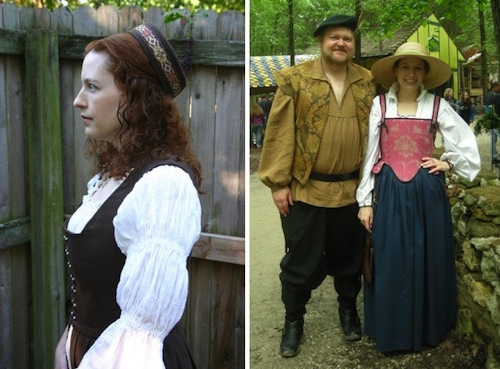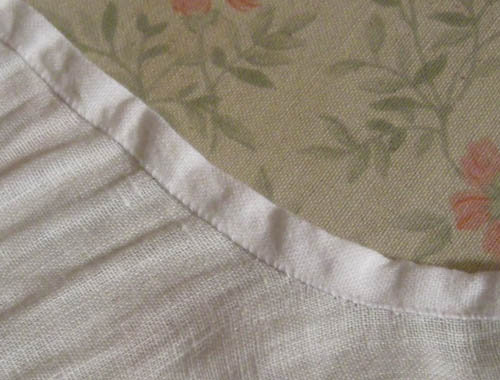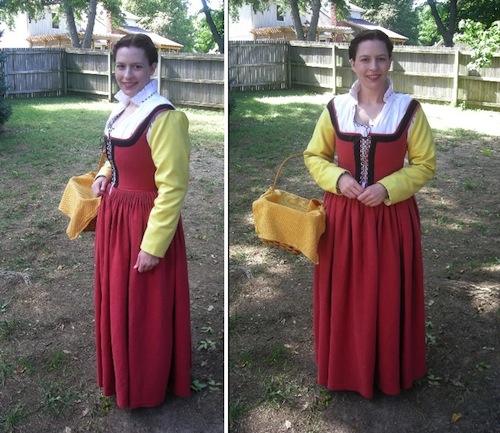See How Elizabeth Creates Historical Garb.
Today, we talk to Elizabeth about sewing beautiful historically accurate garments. She lets us in on what she finds most difficult about recreating a certain period in history and why she loves the challenge! She shares some experiences with us, as well as offers useful tips for anyone who loves to sew re-enactment clothing.
Hi Elizabeth! Please tell us a little bit about yourself and how your love of sewing developed.
In my professional life, I’m an author of historical fantasy for young adults; my most recent book just came out this week (Liar’s Moon, which is set in a fantasy world inspired by the Italian Renaissance). My interest in and appreciation of historical clothing and needlework techniques has only grown along with the research I do for my novels (I have to be careful, or I end up with full sets of garb for every period I write about!).
You can visit my website at www.elizabethcbunce.com to learn more about my costuming and my books.
What types of garments do you enjoy sewing?
I have a real fondness for small bits and accessories–partlets, hats, bags (I’m currently at work on a blackwork tie-on pocket), and I’ve just this year discovered how much I love making sleeves! I don’t know if it’s the speed with which these smaller items can be whipped up, or the emphasis on handwork they can require, or just how much more finished and authentic they can make a period ensemble look.
I’m also very drawn to middle-class costuming; the noble gowns get all the glory, but there’s something so alluring to me about the attention to the clean lines, practical construction, and emphasis on silhouette over glitz.
Do you prefer representing a particular time period with your garments? What attracted you to this era?
Although I can get hooked into any period I’m researching/writing about, my first love is and always will be the Renaissance. My interest in costuming grew out of my love for fantasy, and I grew up on stories of kings and queens and wizards and warriors, and the Renaissance just exemplifies that setting for me. My husband’s costuming preferences still lean toward the fantastic, so I also find myself making clothes for Gimli the dwarf or Robin Hood.
What are some of the difficulties you encounter while sewing historical garbs?
Just like with mundane (modern) clothing, I think achieving a perfect fit remains sort of the Holy Grail for costumers; every garment looks better if it fits properly, and with historical pieces, fit often makes the difference between a "costume" and real, practical clothing that looks and feels authentic, completing the illusion that the wearer has just stepped out of a portrait.
With historical clothing, the fitting challenges are exactly the same (how to take flat fabric and apply it to a decidedly not-flat body and have it hang properly and fit smoothly, with no unbecoming wrinkles or pulls), but the methods used to conquer those challenges are different.
In another vein, one of the most captivating puzzles of this hobby is working out techniques for garments that have not been widely reproduced yet–looking at period images and trying to determine what all the various details you see are, what function they serve, and how they’re made. Right now I’m experimenting with the very high necklines of early Tudor gowns, and the challenge is getting that neckline to hug the collarbones, even on a very curvy figure, without resorting to modern darts or tucks.
So, where do you usually begin? Walk us through your usual process when creating an attire.
I’m not sure I have a typical process, really, unless we count "slow!" A project might start with a need (for a comfortable, hot-weather dress), a fabric (pink linen damask that’s perfect for a corset, or pinked microsuede that will make fantastic sleeves), a portrait (such as Botticelli’s anonymous young woman in brown) or films (the Lord of the Rings saga or "Much Ado About Nothing"), or even a technique.
My Italian working class ensemble, featured in your recent contest, was sparked by my sudden understanding of curved-front bodice seams/openings. I’d been reading about them for a while, and one day it finally clicked, and I dropped everything I was doing to fit a toile.
Once I’ve decided on a project, I turn two places for the initial research. First, my library of costuming and sewing books (Janet Arnold’s Patterns of Fashion: The Cut and Construction of Clothes for Men and Women C1560-1620, Moda a Firenze, The Tudor Tailor, etc), to see if I have patterns already that will work for me.
Secondly, I look for other costumers’ dress diaries. It’s always easiest and most sensible to use well-established methods to do something, and there are so many talented costumers out there to learn from. If I have a general idea in mind, but not a specific project (like making a more noble ensemble for my husband…in his favorite color of orange), I’ll comb through portraits first to see if anything inspires me.
What element of sewing historically accurate garbs do you feel is your biggest accomplishment?
I’m still relatively new to sewing, and I definitely consider myself very much a student. One thing I am proud of, however, is how much those decades of needlework and stitchery have honed my handwork.
It might not be glamorous, but I have an 18th century linen shift (chemise) I sewed entirely by hand, with French seams and a tape-bound neckline. It was a definite labor of love, and really cemented my passion for all kinds of handwork.
I love leafing through my copy of Seventeenth and Eighteenth-Century Fashion in Detail by Avril Hart and Susan North (a book that features extreme close-up photographs of extant historical garments in museum collections) and comparing my own stitches to the hand sewing in those exquisite garments.
Why do you choose linen for your clothing?
I’ll use finer-weight linen like ILO20 or ILO30 for chemises or other delicates, and the medium weight ILO19 is perfect for dresses, skirts, shirts, tunics, and bodice linings.
I think linen doesn’t always get enough credit for being a luxurious fabric, though. Because it’s so practical, we think of it as peasant wear, but the fact that it takes colored dyes so brilliantly, and then washes up softer than anything, makes it truly one of the most pleasurable fabrics to work with and wear.
What have you sewn mostly recently?
My late 1500s Italian working class ensemble is my latest piece, from a pattern I draped on myself, inspired by the artwork of Pietro Ronzelli, Vincenzo Campi, and others. It’s made from your versatile ILO19, in English Rose, lined with Ginger (left over from a shirt I made my husband), cotton twill tape for the guards, and wool sleeves.
Also this year, I made a damask gown with reversible paned sleeves, but I’m afraid it wasn’t linen (although interested readers can check out my dress diary for pictures and construction notes: http://elizabethcbunce.wordpress.com/)
When do you get to show off your beautiful designs?
I try to make things we can wear to our local Renaissance fair, the Kansas City Renaissance Festival. But since that’s only a few weeks out of the year, I also keep a dress diary as part of my website (see link above).
I’m also active in an online costuming group at Renaissancefestival.com/forums, where we share tips and projects. I’m very honored to have this opportunity to share with fellow linen-lovers!































6 Comments
Florine Carr
For eighteenth century clothing patterns and techniques, you might want to check out two books:
“What Clothes Reveal” by Linda Baumgarten,
and
“Costume Close-up: Clothing construction and Pattern 1750-1790” also by Linda Baumgarten along with John Watson and Florine Carr.
Both books published through the Colonial Williamsburg Foundation, Williamsburg, VA.
Rogues of Thread
Great interview guys. Thanks! I also enjoy making middle class costume out of linen. Versatile stuff that linen! I agree with Elizabeth about the bits and accessories. They can make a costume and often feel less daunting to complete than a whole costume. A set of sleeves can be a nice upgrade to a previously made bodice or doublet and historically that is exactly the kind of thing that would be made to update a person’s clothing.
Here is one of my recent creations – a Elizabethan doublet, breeches and tall hat of linen: http://bythebodkin.wordpress.com/2011/08/11/the-lord-mayor-a-costume-autopsy/
Nicola de Coventre
This work is very exciting and interesting. I share the same love of handwork. I’m a member of the SCA in Australia and the Barony I am a part of is mainly 16th c – the Flemish peasant garb, Italian court garb, and Tudor court garb. We use many of the same references too. Your web-diary is fascinating. I love linen too. My current project is a 16th c linen shirt for my husband. My last project was a French hood. Can’t wait to see what you do next.
Wendy Walecka
Wonderful article! I play with Society for Creative Anachronism and although my persona is generally 15th c. Welsh, I love to play with all different kinds of costume types. I had a friend make a replica of Mary of Hapsburg gown from Hungary http://www.virtue.to/guest_authors/hungarian.html in our Barony’s colors when I was event steward for Crown Tourney a couple years ago. It still is not quite what I was hoping for and I am not skilled in draping on myself. I’d love to take a class to learn more of that technique.
I do love linen and silk for most of my gowns. I have a lovely deep purple raw silk that I used for one of my first kirtles. I used a lovely green jaquard with a strawberry pattern for a “gates of hell” sideless surcoat for the overdress and have rabbit fur trim on it. I wish I would have gotten artificial fur trim, but I found it in the fabric district in Los Angeles for a deal. I’d love to redo that pattern, though. It was one of my first attempts in SCA sewing.
My goal is to do one fairly simple Elizabethan, one bliaut, and a Burgundian style dress in my Kingdom’s colors. I also need camp wear! So much sewing, so little time…I look forward to reading more entries in your sewing blog.
Sarah Jane
What a wonderful article to read and be inspired by. Your clothing creations are beautiful, the fit is fantastic and you look like you stepped out of a painting!
Jennifer Arnold Delgado
wow.I enjoyed the description of your process as much as the beauty of the work. I will check out the book.